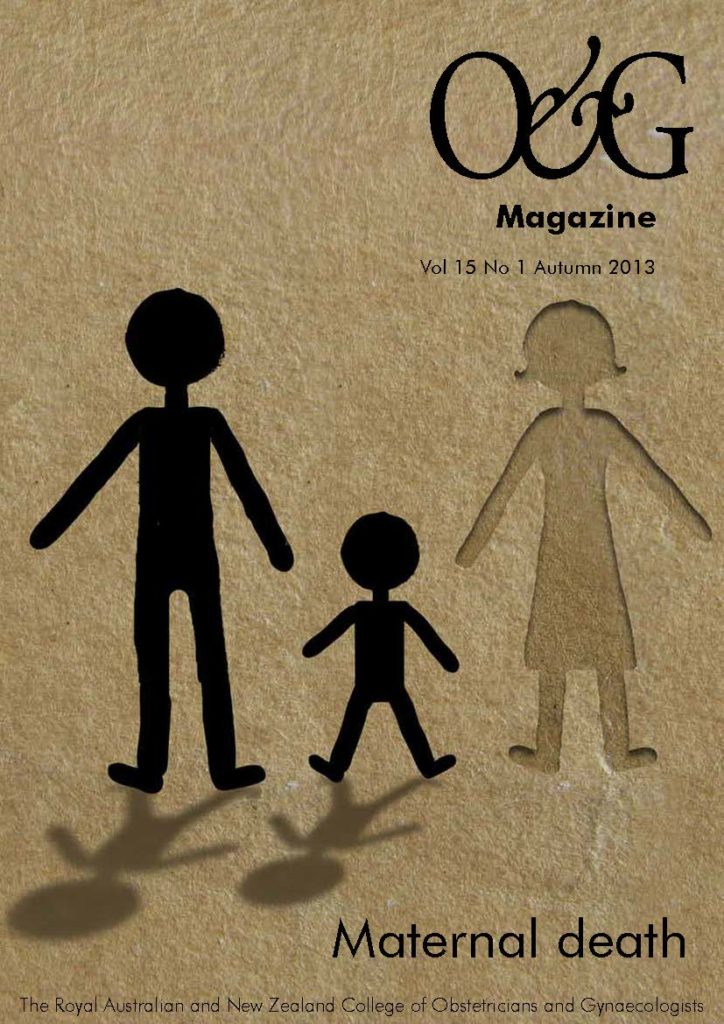While the maternal mortality rate in Australia is gratifyingly low, cardiac disease remains a major cause of morbidity and mortality in young mothers.
Precise data relating to Australia are difficult to obtain, but the most recently published data from the UK show that cardiac disease associated with, or aggravated by, pregnancy is the commonest indirect cause of maternal death.1 Some of the more common causes of maternal morbidity and mortality are discussed below.
Congenital heart disease
The treatment of congenital heart disease (CHD) in children has improved and increasing numbers of women with CHD are reaching childbearing age (there are now more adults with CHD than children). Thus, CHD is commonly encountered in pregnant women. In most cases, significant CHD will be known before pregnancy and pre-pregnancy assessment and counselling is strongly recommended. Fortunately, most women with CHD, tolerate pregnancy well. However, the risks are increased and depend on the specific cardiac lesion and associated factors, such as left and right ventricular function, severity of valvular stenosis or regurgitation, functional status and the presence of cyanosis or pulmonary hypertension.
Pulmonary artery hypertension, whether primary or secondary to congenital heart disease (Eisenmenger syndrome), is generally considered a contraindication to pregnancy and, if pregnancy occurs, termination should be considered. The maternal and fetal mortality rate is extremely high and, if pregnancy proceeds, these patients should be managed in a tertiary facility.
Acquired heart disease
Coronary artery disease and myocardial infarction
Atherosclerotic coronary artery disease was rarely seen in pregnant women several decades ago. However, ischaemic heart disease has now become a common cause of death in pregnancy. It is likely that increasing maternal age, together with an increase in the prevalence of traditional risk factors such as obesity, smoking, hypertension, hypercholesterolaemia and diabetes, has contributed to the increased incidence of myocardial infarction during pregnancy.
Women with pre-existing coronary artery disease are at significantly increased risk during pregnancy and the immediate postpartum period, and should be monitored closely by a cardiologist.
Pregnant women may also present with quite atypical features of ischaemia, such as shortness of breath, vomiting or dizziness. There should be a low threshold for further cardiac investigations, including serial electrocardiograms (ECGs), troponin levels and stress testing in women who present with ischaemic-sounding symptoms, especially in those with cardiac risk factors.
In patients presenting with an acute coronary syndrome (ischaemic pain together with ECG changes), early recognition allows acute coronary intervention to be performed, usually with coronary stenting. An aggressive interventional approach in acute coronary syndrome will also facilitate the diagnosis of coronary artery dissection, a rare, but often fatal, condition that is more likely to occur during pregnancy or the postpartum period. This condition may also be successfully treated by coronary stenting.
Aortic dissection
Aortic dissection is a rare, but lethal, condition in pregnancy. Risk factors for aortic dissection include Marfan syndrome and other connective tissue disorders, bicuspid aortic valve, coarctation of the aorta or a previous coarctation repair, hypertension and pre-eclampsia. Women with Turner Syndrome appear to be at significantly increased risk of aortic dissection, even in the absence of associated cardiac anomalies, such as bicuspid aortic valve or coarctation of the aorta. This risk appears to be further increased if pregnancy has resulted from in-vitro fertilisation, which is usually the case. Aortic dissection may also occur in apparently normal pregnant women, usually near term.
Aortic dissection usually presents with very severe chest, abdominal or back pain, requiring opiate analgesia for relief. In any patient with such pain, requiring strong analgesics, there should be a high index of suspicion for the diagnosis and further investigations should be performed, including a chest x-ray and a computed tomography scan of the chest, magnetic resonance imaging of the chest or echocardiography (transthoracic or transoesophageal). Even when the diagnosis is made in a timely manner, and urgent surgery performed, maternal and fetal mortality remain high.
Summary
- Heart disease in pregnancy is becoming an increasing problem – it encompasses a wide spectrum of disorders.
- Ischaemic heart disease, previously rarely seen in pregnancy, is becoming more common. Patients with ischaemic-sounding symptoms
- or risk factors for coronary artery disease, should be assessed and investigated rapidly.
- Women with pre-existing cardiac lesions should be evaluated and counselled with respect to the risk they encounter with pregnancy.
- Contraindications to pregnancy include severe pulmonary hypertension or Eisenmenger’s syndrome, cardiomyopathy with severe
- symptoms, severe uncorrected valvular stenosis, unrepaired cyanotic CHD and a dilated thoracic aorta. A history of PPCM is a relative contraindication.
- High-risk patients should be managed in specialised centres by a multidisciplinary team.
Peripartum and other cardiomyopathies
Peripartum cardiomyopathy (PPCM) occurs in the latter stages of pregnancy or within six months postpartum, with an incidence that varies from 1:300 to 1:4000 pregnancies, depending on the population studied. Risk factors include multiparity, ethnicity, smoking, diabetes, hypertension or pre-eclampsia and advanced age of mother or teenage pregnancy. Women with PPCM present with symptoms of breathlessness, orthopnoea and peripheral oedema, sometimes very acutely. These symptoms may be difficult to differentiate from symptoms often noted in normal pregnancy and, therefore, a chest x-ray and an echocardiogram should be performed.
Patients with a prior history of PPCM should be assessed by a cardiologist pre-pregnancy for risk-assessment and pre-pregnancy counselling. Any residual left ventricular function indicates an increased risk of heart failure during a subsequent pregnancy. Even in patients with normalised left ventricular function, a subsequent pregnancy may be associated with deterioration in ventricular function. Thus, patients with a prior history of PPCM should be closely monitored, with regular echocardiograms throughout pregnancy.
Women with known dilated or hypertrophic cardiomyopathy also have an increased pregnancy risk and should have expert pre-pregnancy assessment and counselling.
Rheumatic valvular disease
Rheumatic heart disease (RHD) continues to decline as a major cause of maternal mortality in the Western world. However, it remains a major cause of morbidity and mortality in developing countries and also in Indigenous Australians. Continued migration from countries with a high incidence of rheumatic fever means RHD will remain an issue in Australia. Most patients with RHD tolerate pregnancy well, but patients with severe valvular lesions, especially stenotic lesions, often deteriorate in the third trimester or during labour and delivery. Women with known severe rheumatic valvular disease should have cardiac intervention (percutaneous or surgical) prior to pregnancy, since intervention during pregnancy is performed at high maternal and fetal risk.
Table 1. Modified WHO classification of maternal cardiovascular risk: principles.2
| Risk class | Risk of pregnancy by medical condition |
|---|---|
| I | No detectable increased risk of maternal mortality and no/mild increase in morbidity. |
| II | Small increased risk of maternal mortality or moderate increase in morbidity. |
| III | Significantly increased risk of maternal mortality or severe morbidity. Expert counselling required. If pregnancy is decided upon, intensive specialist cardiac and obstetric monitoring needed throughout pregnancy, childbirth and the puerperium. |
| IV | Extremely high risk of maternal mortality or severe morbidity: pregnancy contraindicated. If pregnancy occurs termination should be discussed. If pregnancy continues, care as for class III. |
Modified from Thorne et al. 3
Table 2. Modified WHO classification of maternal cardiovascular risk: application.2
| Conditions in which pregnancy risk is WHO I |
|---|
Uncomplicated, small or mild
|
| Successfully repaired simple lesions (atrial or ventricular septal defect, patent ductus arteriosus, anomalous pulmonary venous drainage) |
| Atrial or ventricular ectopic beats, isolated |
| Conditions in which pregnancy risk is WHO II or III |
| WHO II (if otherwise well and uncomplicated) |
| Unoperated atrial or ventricular septal defect |
| Repaired tetralogy of Fallot |
| Most arrhythmias |
| WHO II–III (depending on individual) |
| Mild left ventricular impairment |
| Hypertrophic cardiomyopathy |
| Native or tissue valvular heart disease not considered WHO I or IV |
| Marfan syndrome without aortic dilatation |
| Aorta <45mm in aortic disease associated with bicuspid aortic valve |
| Repaired coarctation |
| WHO III |
| Mechanical valve |
| Systemic right ventricle |
| Fontan circulation |
| Cyanotic heart disease (unrepaired) |
| Other complex congenital heart disease |
| Aortic dilatation 40–45mm in Marfan syndrome |
| Aortic dilatation 45–50mm in aortic disease associated with bicuspid aortic valve |
| Conditions in which pregnancy risk is WHO IV (pregnancy contraindicated) |
| Pulmonary arterial hypertension of any cause |
| Severe systemic ventricular dysfunction (left ventricular ejection fraction <30%, NYHA III–IV) |
| Previous peripartum cardiomyopathy with any residual impairment of left ventricular function |
| Severe mitral stenosis, severe symptomatic aortic stenosis |
| Marfan syndrome with aorta dilated >45mm |
| Aortic dilatation >50mm in aortic disease associated with bicuspid aortic valve |
| Native severe coarctation |
Adapted from Thorne et al.3
Infective endocarditis
Infective endocarditis is rare in pregnancy (1:100 000 pregnancies), but is associated with a very high maternal and fetal morbidity and mortality, mainly owing to heart failure and thromboembolic complications (up to 33 per cent in one study). Predisposing conditions include congenital heart disease, acquired valvular disease and intravenous drug use, with the highest risk occurring in those with prosthetic heart valves or prosthetic material used for previous repair. Infective endocarditis should be treated the same way as in non-pregnant patients, bearing in mind the potential risk of certain antibiotics. Cardiac surgery is associated with a high risk of fetal loss and delivery should be performed prior to cardiac surgery, if possible.
Mechanical prosthetic valves
Mechanical prosthetic valves represent a major risk to successful pregnancy, mostly as a consequence of valvular thrombosis. The safest option for the pregnant woman is to remain on warfarin throughout pregnancy. However, warfarin, particularly at doses greater than 5mg/day, may cause an embryopathy. There are several strategies used for managing the problem of anticoagulation during pregnancy, including continuing warfarin if the daily dose is <5mg/day, changing to low molecular weight heparin (LMWH) injections from weeks five to 15, to minimise the risk of warfarin embryopathy, or using LMWH throughout pregnancy. Careful monitoring of LMWH dose, guided by anti-Xa levels and good compliance is extremely important in obtaining a good outcome. Whatever strategy is used, these women are at extreme risk of complications and should be managed in a multidisciplinary tertiary facility.
Maternal risk assessment
The European Society of Cardiology Guidelines on the management of cardiovascular diseases during pregnancy recommend that maternal risk assessment is performed using the modified World Health Organisation (WHO) risk classification.2 This risk classification includes all known cardiovascular risk factors, including the underlying cardiac abnormality. Table 1 depicts the general principles of this classification. Table 2 outlines the application of the principles in specific conditions.
References
- Centre for Maternal and Child Enquiries (CMACE). Saving Mothers’ Lives: Reviewing maternal deaths to make motherhood safer:2006-2008. BJOG 2011; 118 (Suppl 1), 1-203.
- The Task Force on the Management of Cardiovascular Diseases during Pregnancy of the European Society of Cardiology (ESC). ESC Guidelines on the management of cardiovascular diseases during pregnancy. European Heart Journal 2011;32:3147-3197.
- Thorne S, MacGregor A, Nelson-Piercy C. Risks of contraception and pregnancy in heart disease. Heart 2006;92:1520–1525.





Leave a Reply